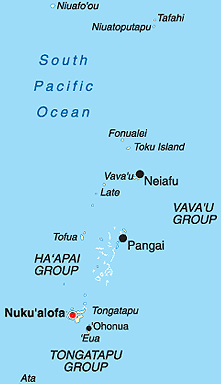Our cruising guide describes Niuatoputapu as looking like "a slightly squashed sombrero". As we were entering the country from American Samoa to the northeast we aimed for the Niuas, and this is the only one with a protected lagoon suitable for yachts. It's a volcanic island that is eroding away into its lagoon, which is a lovely kind of island for people to live on. There is a range of growing zones from the tidal flats to the hills, with lots of fairly flat fertile land on which to grow crops. Niuatoputapu also has a fairly large lagoon on the leeward side with plenty of room for yachts to anchor, supply ships to dock, and turtles to swim around doing whatever turtles do. Though the book warns that the pass is narrow and shallow, it looked wide and easy to our little boat. We were the only visiting yacht for much of our time here.
This island was swept by a 17 meter tsunami wave in 2009, which wiped out most of the buildings and farmland. Thanks to the quick thinking of locals who remembered the signs of a tsunami, most people made it to high ground in time to save themselves. One highschooler we spoke to described the experience of running uphill with her family, with the noise of the wave behind her. Most villagers live in new little modular houses brought in by the government, though a handful were able to save the cinderblock frames of their original houses.
|
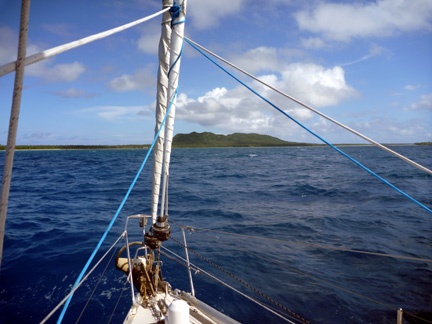
|
|
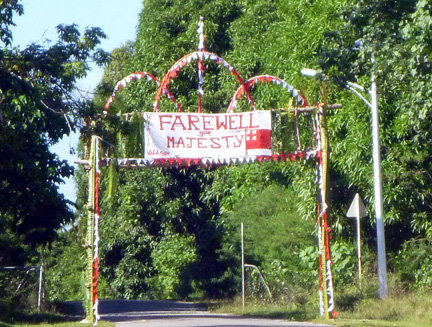
|
We were quite charmed when we arrived ashore to find several beautifully decorated arches with colorful banners over the 1.5 mile road between the warf and the government center. Then we saw this banner on the road heading to the airport, and realized we had missed the King's birthday visit by a scant couple of days. The King and Queen make a tour of the four island groups every year for his birthday, going north by boat and then flying home from Niuatoputapu. By the time we arrived there were people taking apart the fairgrounds where they had shown the bounty of their land and sea to the King, and using the wood for other projects. This also meant that everyone was rather short on ripe fruit for our first week, having given it to the communal feast.
|
|
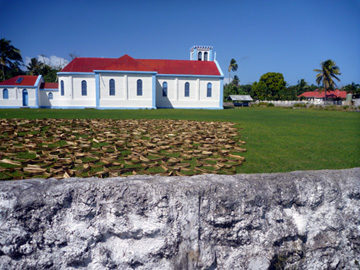
|
Tonga is a devoutly Christian country (it's in their constitution), though they don't seem as concerned about differences between the sects as folks in the US are. This is the largest Catholic church in Niuatoputapu, which was having it's pews scrubbed on the lawn the first day we saw it. This day there are pandanus leaves drying in preparation for weaving new floor mats. Every village has a church from each available sect (there weren't Mormons on this island, though we hear there are in other parts of Tonga), and the locals clearly take pride in keeping a big and spiffy church even if the village doesn't supply enough parishioners to fill it.
|
|
Niuatoputapu is primarily a self-contained subsistence economy, in which every family eats what they grow/raise/collect from the land and sea. Their only export seems to be pandanus weavings, for which they are famous around Tonga. Everyday (except Sunday) we saw groups of women working on pandanus. The beautiful weavings are the product of a long process involving harvesting, trimming, boiling, then soaking the leaves on the tidal flats for a week before they can be finally washed and sun-dried. Every low tide we watched families out on the exposed coral rock exchanging or checking on their bundles of pandanus that were soaking in the lagoon. It seems like a laborious process, but also a convivial good time as the women sing and chat while working in groups.
|
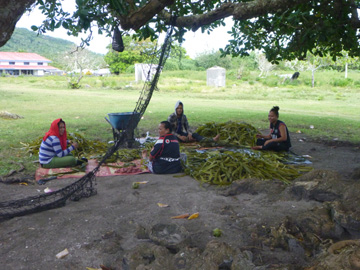
|
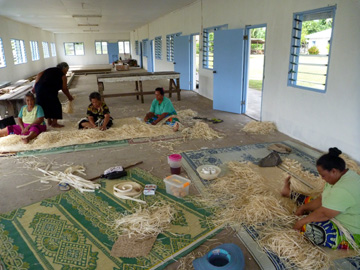
|
Once the pandanus has gone through the two-week process, the salt bleached and softened leaves are woven into tight mats to be worn or to cover the floor. Women gather in the shade of the airy village hall to weave with friends and family. The ladies at the back are weaving a new aisle runner for the Catholic church, and the one in the foreground is weaving a ta'ovala (waistmat garment) to be sold at the tourist market in the capital city. I was amused to realize that the mats the ladies are sitting on are recycled plastic ones from China, rather than their own beautiful weavings.
|
|
|

|
|
|
A high point of our stay here was interacting with the local high school. Niuatoputapu High School is the only high school in the Niua group, so students from the other two islands must board here to attend, usually with extended families. Even with students from the entire group, the school has an average of twenty students per grade level, ranging from Form 1 (7th grade) to Form 7. One wing of their complex houses the local elementary school as well, and they all share a breezy auditorium/gym with a stage. This was all built new after the tsunami, up the hill from the tsunami memorial cemetary.
Bonnie got permission to shadow an English teacher for a day, which was great fun as she helped to act out a poem. She also observed other teachers at the school, including the Assistant Principal as he taught his Accounting class in the library, and was positively impressed with the professionalism and technique of each teacher. Tongan students struck us as amazingly polite and respectful, and seem to be trying very hard even when the going gets tough. Teachers, like government officials, are frequently assigned to these outer islands for a couple years at a time, and many live on the school grounds. The teachers who come from this community were very proud to tell us so.
A particular favorite student was Josiah, who stopped his bicycle to talk to us on our very first day ashore. He was very friendly and helpful, giving us directions and inviting us to ask at his family if we need fruit. We never actually figured out which house belonged to him, but we enjoyed seeing him at school, where he punctiliously called us by our names and asked if we remembered his. How could we forget!? Our time at the school happily coincided with a planned English Week, to encourage the students to stretch in this second language that they will need for higher education. On Character Day Josiah stood out as a "waiter" - clearly a fancy one with the bowtie. There were other entertaining costumes like princesses and Zorro, but most students dressed professionally and were "teachers". We stayed one afternoon to attend the English games in the auditorium, where we clapped loudly for Josiah in the Form 1 spelling bee.
While Bonnie was trying to live up to the heroic profession of teacher, Paul was doing the actual hero work of fixing computers. The school has a dedicated computer lab, since the students must pass the national tests on computer skills, but when Paul arrived only three of the computers were working. He sorted through cabinets of old desktops to piece together two more working computers. This thrilled the computer teacher and the Principal. We wish we could snap our fingers and give new equipment to these wonderful students who are working so hard to compete for scholarships to higher education. Update: it's happnening! Click on the link below to see what we're doing, and help us with it!
|
|

|
|
|
Niuatoputapu is primarily an agrarian community. Every family has a plot of farming land, not usually attached to the land where their house is. They grow bananas of several varieties, papaya, coconuts, pandanus, taro, manioc, and several kinds of greens we were unfamiliar with. They also raise pigs (which they feed coconut - yum!), horses, dogs, and some sheep and goats. Horses are usually tethered to feed in fields and on roadsides, but pigs are very common and free-ranging. They even wander out on the exposed reef at low tide! The pigs are not at all agressive, put adults are also not generally scared of humans. They tend to watch calmly while their brood of piglets run squealing away from us, or after each other, or for no reason we could understand. The one time we managed to set the adult pigs running was when we raised a small camara to take a picture of them - then they led their family tearing into the bushes!
Bonnie's favorite animals on the islands were the little lambs that would graze daily in the field between the high school and the tsunami memorial graveyard. They look so like her sister's favorite stuffed animal that she almost expected them to play music like it did. Every walk near this area required a stop to admire the adorable lambies stumbling around on their clumsy legs. Apparently the sheep are a new addition to the island (surely from New Zealand), and are seen as an experiment.
Paul's favorite animals were the sleek horses. With the recent increase in number of cars, the horses are living lives of comfortable retirement. We only once saw a man riding a horse, and usually they seem to be used as passive lawn mowers. Some have the bony look of older animals, but many are sleek and pretty. We decided not to engage in the heroic communication that might have allowed us a horseback ride - let them enjoy their retirement. Speaking of heroic communication, we decided that meeting our penguins Gunter and Gus might be a little confusing for these charming folks. Also, Gunter was unimpressed with the lack of ice cream on an island that lacks refrigeration.
|
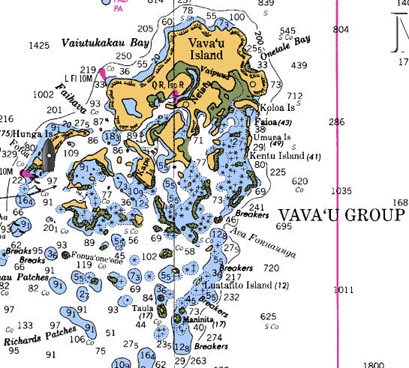
|
Vava'u is the island group of Tonga that is most commonly visited by sailboats. It is considered a bucket-list destination for most cruisers, and it's easy to see why. The eroding volcanic islands create a maze of wide channels and many protected anchorages, all within a couple hours of each other. The hills protect boats from the trade winds, but the currents still bring clear ocean water to feed the gorgeous reefs. Much of the lower shoreline is obviously old coral that has been geologically uplifted a few meters, making lots of sea caves and exciting formations where the water wears it away. The southern humpback whales use Vava'u's warm waters as a safe spot to winter, have babies, and make more babies. This is one of the few countries where it is legal to swim with the whales, though the government does require swimmers to be with a professional guide who is supposed to follow regulations to protect the whales.
|
|

|
|
|
Vava'u's main town is Neiafu, at the head of a harbor so protected on all sides that it's almost a lake. The channel is just large enough for the supply ships to get through, but big cruise ships anchor outside. The town itself is wonderfully compact, making walking easy, with a pleasantly bustling atmosphere during the tourist season (winter). Many locals and expats from all over the world run businesses geared to yachties and other tourists, and at the height of the season there may be over sixty visiting boats moored and anchored in the harbor. Local farmers and artisans run a busy market near the main warf, with exotic things like tomatos, carrots and fresh herbs in addition to the usual tropical produce. This stall of carvings was a particular favorite for the lifelike humpback whales. Some items are carved from whale bones that the artists assured us were very old and found on beaches.
|
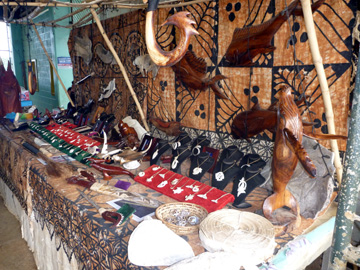
|
Coral |
|
|
It seemed like every time we got in the water in Tonga we saw something we'd never seen before. The best coral gardens (with the best water clarity) were always outside the lagoons where they got washed by the open ocean currents. Paul dove down to get pictures of big coral formations while Bonnie enjoyed the scene floating on the surface. We found "Darth Coral" in the middle of a narrow pass with these brilliant gorgonian fans and soft corals fluttering in the current.
|
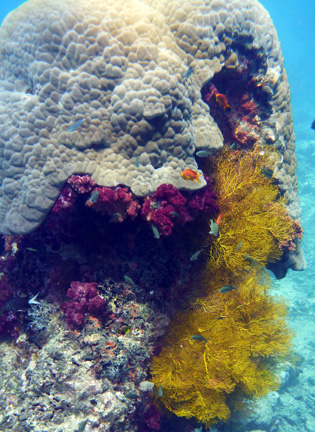
|
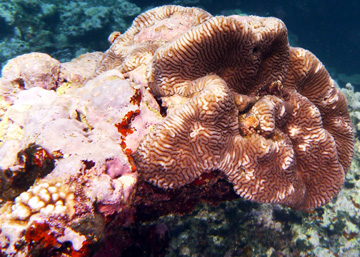
|
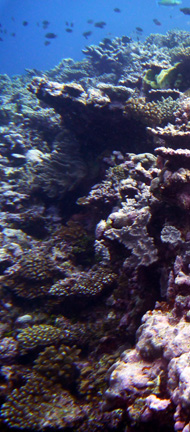
|
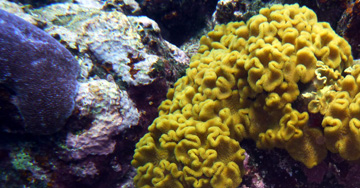
|
Fishes too |
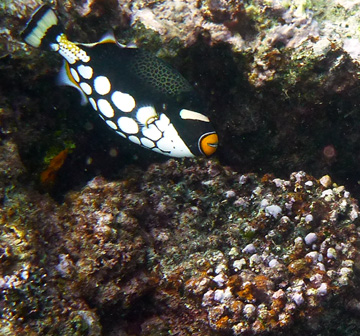
|
|
We also encountered several species of fish that are new to us. The handsome polka-dot character on the left is a clown trigger fish. He is related to the Hawaiian state fish, but is more of a partier than a warrior. The comically luscious mouth of the fish in the center earns him the appropriate name: many-spotted sweetlips. But apparently he thinks his tail is his best asset. The amazingly regal purple and gold fellow we thought was a wrasse turned out to be a blackside hawkfish.
|

|
|
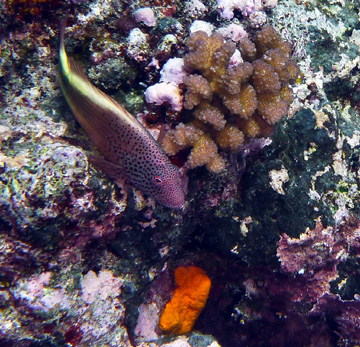
|

|
The Ha'apai group is largely composed of reef islands, with some volcanic islands mixed in. Reef islands are similar to atolls - places where a coral reef grew, and then was raised a little above sea level by geological changes. Sand gradually accumulates on the uplifted reef, and some hardy plants like coconut palms and mangroves scrape out a living, and their detritus makes a kind of thin soil for a few other plants. That's all though, just a few types on plants in sandy soil surrounded by the live coral that's still in the water. Atolls are circle reefs that formed around an island before the island eroded. The Ha'apai islands are largely on a barrier reef formation, so they string along big crescent shapes running north to south. West of that primary barrier there are a few volcanic islands with rich black soil and more varied agriculture. All these islands have reef surrounding them, and there are many random coral bommies that make shallow spots that boats should avoid. This panorama is of an uninhabited island that seemed to us like the perfect tropical desert island - our own private paradise until another boat came to share the anchorage.
|
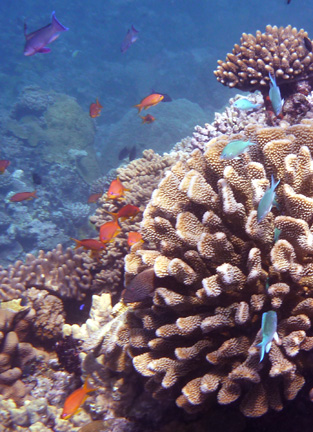
|
Ha'apai has a lot of coral with a lot of clean ocean water washing past it, and not very many people living on the scattered islands. The result is a lot of pretty and healthy reef habitat, with lots of coral and fish variety. We were amazed everytime we snorkeled here, as we encountered new species of coral and fish that we hadn't seen in the eastern Pacific. Our favorite spots were reefs that are open to the clear ocean water, but deep enough to not get beat up by big waves in storms. Many of these beautiful pictures were taken at a spot near the uninhabited island that is pictured in the panorama above. The water was crystal clear, and we got cold from the ocean current long before we tired of looking at the beautiful gardens of corals, sponges, anemones, and probably things we can't even identify. There were also a couple of huge Pacific Painted lobster hiding under a ledge, but those guys don't get big by being dumb enough to get caught.
|
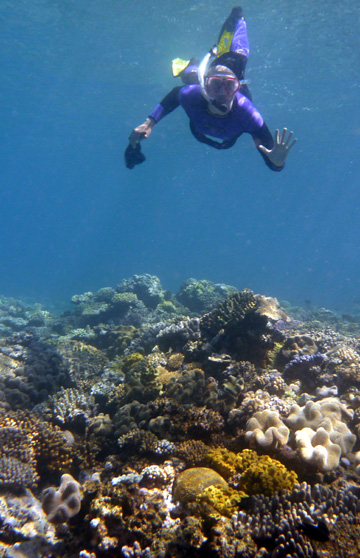
|
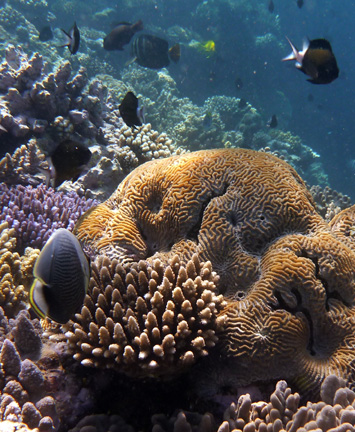
|
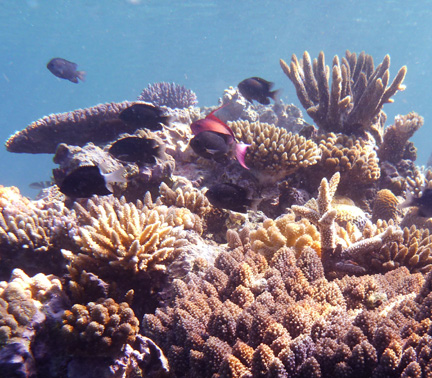
|
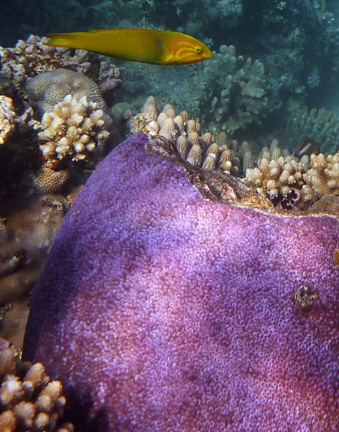
|
Whales! |
|
The most awesome creatures that visit Tonga every year are definitely the whales. Humpback whales, and sometimes other species like sperm whales, use Tonga's warm and comparatively shallow waters to give birth and raise their calves until they're big enough to swim to the Antarctic ocean for the southern summer. Mama humpbacks usually find a protected lagoon in which to give birth, and are frequently attended by a "midwife" female as well. We lucked out, and these amazing creatures were hanging out at the same island we were for a few days. They would leave the lagoon sometimes (we assume for the adults to find food), but would return each day to rest in the protected water behind the reef. While the adults napped the calf would cavort around them, and sometimes the adults would lazily slap the water with their long flippers. One day Paul was in the water when they approached our boat, and they were willing to pose for a few pictures before slowly moving on. The water in the lagoon was a touch murky from the microorganisms that bloom in warm water, but Paul was still able to enjoy floating near these giant mamas. The big adults did a full circuit around Paul before allowing him to see their adorable little fifteen-foot baby.
|
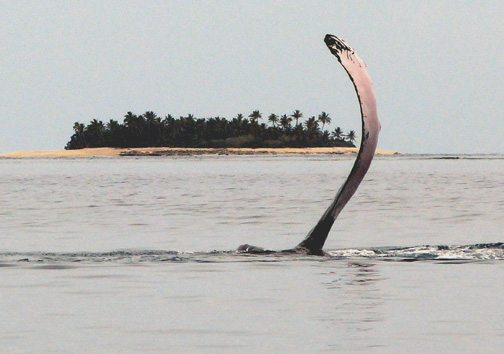
|
|
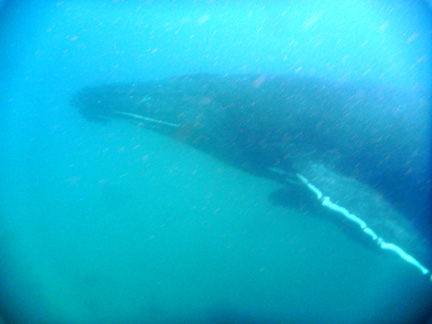
|
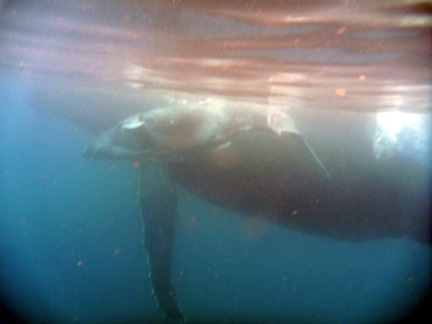
|
|


